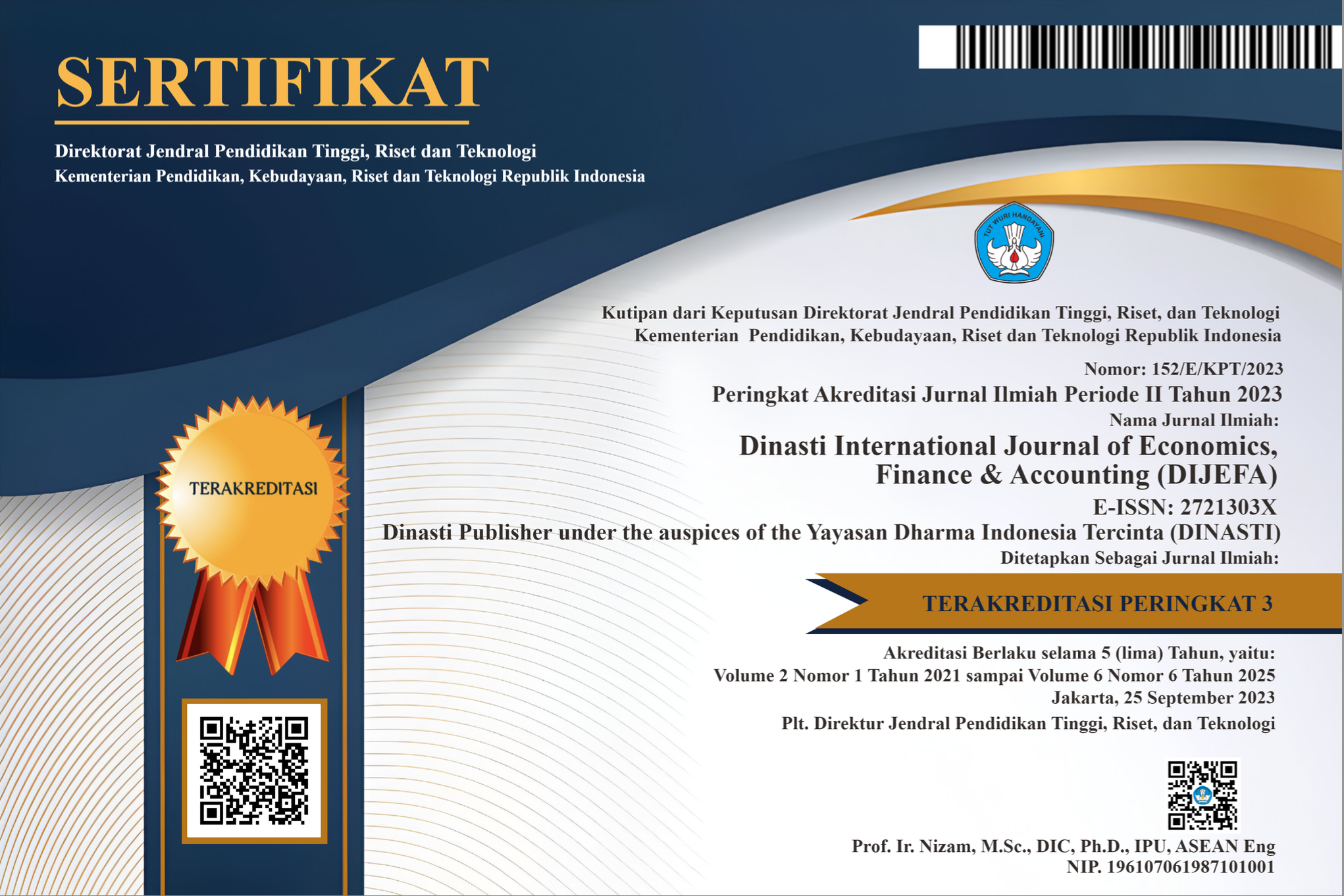Literature review: the Effect of Company Size, Company Growth, and Company Liquidity on Going Concern Audit Opinion
DOI:
https://doi.org/10.38035/dijefa.v3i4.1438Keywords:
Going Concern Audit Opinion, Company Size, Company Growth, Company LiquidityAbstract
Factors affecting going concern audit opinions have always been the focus of academic research. This article categorizes relevant previous research in Indonesia and analyzes several variables affecting audit opinion. This article examines the relationship or effect of company size, company growth, and company liquidity on going concern audit opinions, a study of auditing literature. This article aims to build a hypothesis of the effect between variables to be used in further research. This literature study shows the following results: 1) Company size has a negative effect on going concern audit opinion; 2) Company growth has a negative effect on going concern audit opinion; 3) Company liquidity has a negative effect on going concern audit opinion. This article provides a reference for more in-depth research on the factors affecting going concern audit opinions.
References
Al Fath, N. D. & Sugito, Pudjo. (2020). “Pengaruh Debt Default, Pertumbuhan Perusahaan, dan Ukuran Perusahaan Terhadap Penerimaan Opini Audit Going Concern”. Buletin Studi Ekonomi, 2(1): 265-286.
Andini, B. N., Subandi, & Peristiwaningsih, Yantik. (2021). “Pengaruh Profitabilitas, Likuiditas, Ukuran Perusahaan, dan Pertumbuhan Perusahaan Terhadap Opini Audit Going Concern (Studi pada Perusahaan Manufaktur Yang Terdaftar di Bursa Efek Indonesia Tahun 2014-2017)”. Media Mahardhika, 19(2): 380-394.
Aprianti, Ritha & Surya, Sarjito. (2020). “Pengaruh Kondisi Keuangan dan Ukuran Perusahaan Terhadap Opini Audit Going Concern”. Jurnal Sains Manajemen Akuntansi, Volume/Januari/2020.
Arens, A., Elder, R. & Beasley, M. (2008). Auditing dan Jasa Assurance: Pendekatan Terintegrasi. Edisi 12. Alih Bahasa: Herman Wibowo. Buku 1. Jakarta: Erlangga.
Bosse, D. A. & Phillips, R.A. (2016). “Agency Theory and Bounded Self-Interest”. Academy of Management Review, 41(2): 276–297.
Endiana, I. D. M. & Suryandari, N. N. A. (2021). “Opini Going Concern: Ditinjau dari Agensi Teori dan Pemicunya”. Ekuitas: Jurnal Ekonomi dan Keuangan, 5(2): 223-243. DOI: 10.24034/j25485024.y2021.v5.i2.4490.
Gusti, Q. R., & Yudowati, S. P. (2018). “Pengaruh Leverage, Profitabilitas, Pertumbuhan Perusahaan, dan Opini Audit Tahun Sebelumnya Terhadap Penerimaan Opini Audit Going Concern (Studi pada Perusahaan Pertambangan yang Terdaftar di Bursa Efek Indonesia Tahun 2013-2016)”. E-Proceedings of Management, 5(3): 3463-3472.
Jensen, C. & Meckling, H. (1976). “Theory of the Firm: Managerial Behavior, Agency Costs, and Ownership Structure”. Journal of Financial Economics, 3(4), 305–360.
Khairudin & Wandita (2017), “Analisis Pengaruh Rasio Profitabilitas, Debt to Equity Ratio (DER) dan Price to Book Value (PBV) Terhadap Harga Saham Perusahaan Pertambangan di Indonesia”, Jurnal Akuntansi & Keuangan, 8(1): 68–84.
Kuntadi, C. (2019). Audit Internal Sektor Publik. Jakarta: Salemba Empat.
Kuntadi, C. (2020). The Effect of Lowballing on Auditor Independence and Audit Opinion (Case Study at the Public Accounting Office for the Special Capital Region of Jakarta). Research Journal of Finance and Accounting, 11(4), 42–51. https://doi.org/10.7176/rjfa/11-4-05.
Kuntadi, C. (2021). Audit Keuangan Negara. Jakarta: Salemba Empat.
Purba, S. F. & Nazir, N. (2018). “Pengaruh Pertumbuhan Perusahaan, Rasio Keuangan, dan Kualitas Auditor Terhadap Opini Audit Going Concern”. Jurnal Akuntansi Trisakti, 5(2): 199–214. DOI: dx.doi.org/10.25105/jat.v5i2.5238.
Rakatenda, G. N. & Putra, I. W. P. (2016). “Opini Audit Going Concern dan Faktor-Faktor yang Mempengaruhinya”. E-Jurnal Akuntansi Universitas Udayana, 16(2): 1347–1375.
Scott, W. R. (2015). “Financial Accounting Theory (5th ed)”. Pearson Prentice Hall.
Spence, M. (1973). “Job Market Signaling”. The Quarterly Journal of Economics, 87 (3), 355 -374.
Downloads
Published
How to Cite
Issue
Section
License
Authors who publish their manuscripts in this journal agree to the following conditions:
- The copyright on each article belongs to the author(s).
- The author acknowledges that the Dinasti International Journal of Economics, Finance & Accounting (DIJEFA) has the right to be the first to publish with a Creative Commons Attribution 4.0 International license (Attribution 4.0 International (CC BY 4.0).
- Authors can submit articles separately, arrange for the non-exclusive distribution of manuscripts that have been published in this journal into other versions (e.g., sent to the author's institutional repository, publication into books, etc.), by acknowledging that the manuscript has been published for the first time in the Dinasti International Journal of Economics, Finance & Accounting (DIJEFA).


























































